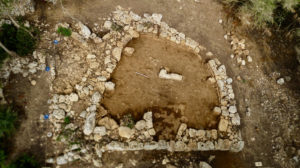
In 2015 a team of archaeologists founded the Sa Cudia Cremada Archaeology Field School, currently focussing on the excavation and study of the prehistoric sanctuary located at the Talayotic site of Sa Cudia Cremada (on Menorca, in the Balearic Islands). After three excavation seasons (the fourth to take place in September 2018), the team has confirmed the discovery of a remarkable taula enclosure, including evidence about its chronology and some of the most typical elements that can be found in these building types.
________________________________
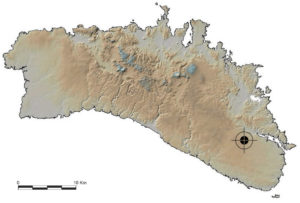
Location of Sa Cudia Cremada at the eastern side of Menorca. Sa Cudia Cremada Archaeology Field School
_________________________________
So what is“Talayotic” and a “taula enclosure”?
Talayotic is the name given to the period roughly beginning around 1200 BC in the Late Bronze Age, characterized by a great social change in the Balearic Islands of Menorca and Mallorca, which was reflected, among other features, in a more complex and stratified social system and a new organization based in settlements that had little or nothing to do with previous settlements. These new villages, known as Talayotic settlements, had at least one talayot — a public tower-shaped structure that could exhibit different shapes and sizes. During prehistoric times, the island of Menorca shared many aspects with its neighbour Mallorca, including the Talayotic culture itself and the construction of talayots. However, both islands had significant differences that can be seen in their respective material cultures and architectural types. In this way, for instance, despite the fact that both islands had talayots, broadly speaking those in Menorca are probably slightly older and, in terms of morphology, larger and presenting several layouts and sizes, whereas the Mallorcan talayots are standardized towers with either a rounded or squared-shaped layout and an internal chamber with a central column. Even though some Minorcan talayots do have an internal chamber with a central column, most of them are solid structures, whose active areas were located at their top platform, which suggests a control of the surrounding territory by those using it, as well as a means for communication purposes with nearby settlements.
The Talayotic period lasted approximately until 500 BC, and the subsequent period is known either as Late Talayotic or Post-talayotic by prehistorians and archaeologists. This new phase within the prehistory of Menorca is characterized by new changes in the society, including a more intense commerce with foreign cultures, especially with the Punics, with whom they traded a variety of products during much of the second Iron Age. During this period, Talayotic settlements experienced several changes, such as the abandonment of talayots, or at least the loss of their primary functions. This period also witnessed the construction and use of new buildings and other structures, such as outer walls, circular-layout houses with an internal courtyard, hypostyle halls and a new public structure type: the taula enclosure. What were these latter enclosures? Archaeologists suggest that they were religious spaces where in certain times of the year the Late Talayotic communities performed their rituals, likely connected to the different stages of the agricultural cycle. These buildings can be found neither in Mallorca nor in other parts of the world and this fact, along with their monumentality, makes them a unique example of monumental prehistoric religious architecture.
Despite the fact that they can present several variations in size and internal elements, all of them are characterized by a horseshoe-shaped layout with a rectilinear façade facing south, a set of pilasters that abut the internal face of the wall and a central monument called the taula, which means table in Catalan, the native language spoken in Menorca. The name was given by Minorcan people long ago, as these monuments resemble big tables that, according to mythical stories and legends, were used by giants who lived on the island. Despite their monumentality and dimensions, we now know that taulas were not tables at all, but symbolic elements erected by men. A taula consists of two large stone slabs that form a T-shaped structure, constructed without mortar and reaching up to 5 meters high and 22 tons, as is the case of the largest one, located in Torralba d’en Salort.
Thus far, more than 30 taula enclosures have been documented on the island, some of which are well preserved with most of their elements in situ, including the taulas themselves. Of those, several were excavated in the 20th century, and the results of these excavations were of high importance in terms of determining their religious function and the practices carried out within them during the Late Talayotic period. In fact, the first scientific excavation project taking place on Menorca had the main aim of excavating a taula enclosure, which was carried out by British archaeologist Margaret A. Murray in the 1930’s. First, Murray directed the excavation of the taula enclosure at the settlement of Trepucó and, a few years later, she also excavated the one at the site of sa Torreta de Tramuntana. In both she found evidence of rituals involving the consumption of food (mainly meat from sheep, goats and pigs) and wine, as well as both native and imported materials, including religious elements such as incense burners depicting Tanit, the Punic goddess of fertility. The ritualistic aspects of these buildings were also attested in the other taula enclosures excavated on the island, including those at Torre d’en Galmés, Binissafullet and Torralba d’en Salort, the latter one being the most stunning example for its high state of preservation, monumentality and dimensions.
Even though we currently have relevant information about these buildings, there is still a lot to do in order to fully understand their chronological, ritualistic and architectural aspects. In this way, in 2015 the excavation of the sanctuary of Sa Cudia Cremada began with the primary objective of finding evidence that could help the team determine the phases of construction, occupation and abandonment of these buildings (through both typological studies of artifacts and a variety of analyses on some remains); the meaning of the rituals performed and the deities worshipped inside; and architecture-related aspects such as the existence or absence of a roof covering the internal space of these enclosures, something that is still under debate among archaeologists working on the island.
_______________________________
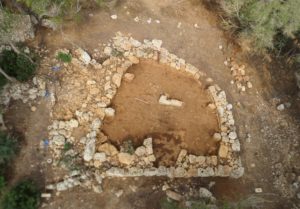
Aerial view of the taula sanctuary of Sa Cudia Cremada at the end of 2016 season. Sa Cudia Cremada Archaeology Field School
_______________________________
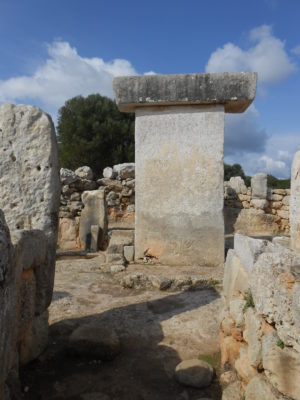
The most stunning example of a taula enclosure: Torralba d’en Salort, which was excavated in 1970’s. This also shows example of a T-shaped stone structure. Sa Cudia Cremada Archaeology Field School
________________________________
The Excavations
With these aims in mind, along with an international field school to deliver high-quality training in archaeological practice (giving students the chance to dig and learn at a unique site), the taula enclosure of Sa Cudia Cremada began to be excavated. After the 2015, 2016 and 2017 seasons, the team has already gathered relevant data on some of these aspects and, without any doubt, the following seasons will continue to shed light on the religious aspects of this unique Mediterranean society. The excavation of this taula enclosure aims to add more information about these buildings by using new methodologies and technologies that did not exist at the beginning and middle of the 20th century, when most of the other taula enclosures were excavated. We can now employ new methods of radiocarbon dating of organic materials as well as analyze the pollen present in the soil we excavate, among other micro-remains, all of them leading to new possibilities such as narrowing the chronologies of the building down with absolute dating and reconstructing the paleoenvironment of the site.
The team and the students who have attended the summer courses in the past three years have uncovered roughly half of the building and, in doing so, its total layout is now exposed, which is horseshoe-shaped and oriented to the South. Also, its main internal features have already been located, including its taula monument, which stands, as expected, in a central position. This taula monument preserves its vertical stone, whereas the lintel that once rested on it is now lost. The vertical stone, however, is still in its original upright position and is flanked on one side by a rectangular stone. Also, a set of pilasters abutting the internal face of the wall have been located, surrounding the taula.
All elements have been uncovered by removing several deposits that overlaid the building and also within, including a significant level composed of a large quantity of tumble stones from the walls. All artifacts recovered so far were located in this and other levels, most of them dating from the Late Talayotic period or second Iron Age. Among these materials, the most abundant is pottery, followed by a remarkable quantity of faunal remains and, in lesser amounts, lithic, bone and metal objects. The pottery assemblage is typical of these contexts and includes a large number of amphorae, most of them originating in Punic Ibiza, followed by amphorae from the eastern coast of the Iberian Peninsula. Also, both native and imported table wares, including cups, jars and storage containers, have been located. Both amphorae and table wares roughly date from the 4th to the 2nd centuries BC, with very few pieces dated to more recent dates. Regarding the faunal remains, most of the bones belonged to sheep, goats and pigs and feature cut marks. Even though these materials, along with those that will be found in future seasons, have to be thoroughly analyzed, we can already state that they define the typical assemblage of artifacts and eco-facts found in a taula enclosure, and most probably suggest the same ritualistic purposes thought to be associated with the other taula sanctuaries previously excavated on the island.
_________________________________
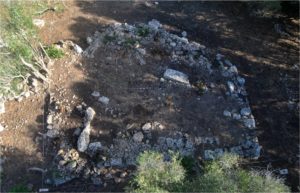
Aerial view of the taula sanctuary of Sa Cudia Cremada before the start of the first excavation season in 2015. Sa Cudia Cremada Archaeology Field School
_______________________________
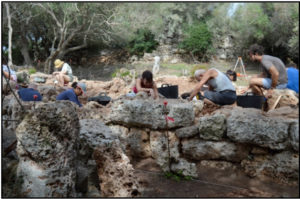
Working shot during fieldwork. Sa Cudia Cremada Archaeology Field School
_______________________________
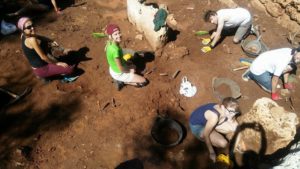
Working with the students in September 2017. Sa Cudia Cremada Archaeology Field School
_________________________________
The Promise of Sa Cudia Cremada
The prehistoric archaeology of Menorca is unique, and researching its archaeological sites has helped to gain more valuable information about the society that thrived and died out on the island during the Talayotic period before the arrival of the Romans at the end of the 2nd century BC. The Talayotic archaeological heritage is currently nominated to World Heritage status by UNESCO, a recognition that would contribute to the dissemination and wider recognition of this amazing heritage, a culture still not very well known outside the Balearics. So far, participants from the USA, Australia, Hong Kong, Netherlands, Belgium, UK and Canada, among other countries, have attended the courses organized by the field school, where they have learned about excavation methodology while applying this knowledge during fieldwork at the site’s taula enclosure. But apart from gaining fieldwork and post-excavation experience, students have discovered an incredibly well preserved prehistoric heritage on a small paradisiac Mediterranean island. All of them have left Menorca feeling touched by the Talayotic culture. By exposing international students to this archaeology we ensure it will be known and respected not only on the island, but also throughout the world. We hope to continue to welcome new students who will learn with the team about archaeological practice while they discover this unique heritage.
For more information about the project, please visit the website: http://archaeologysacudia.com/en/. The registration period for the 2018 season is now open!





